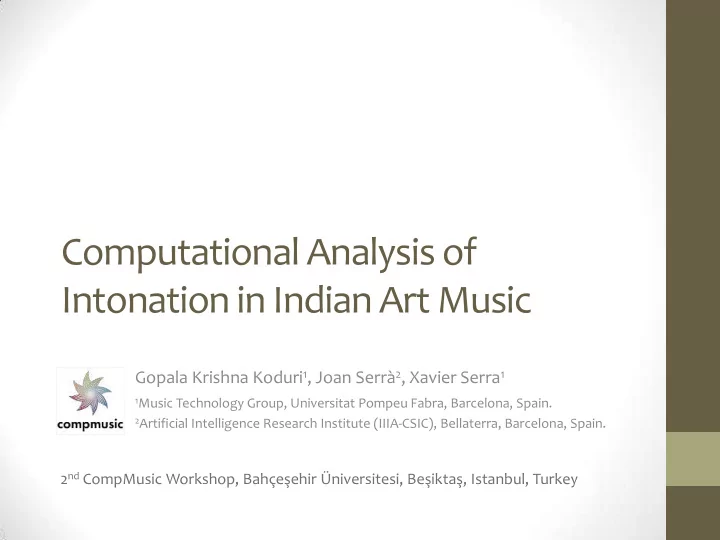

Computational Analysis of Intonation in Indian Art Music Gopala Krishna Koduri 1 , Joan Serrà 2 , Xavier Serra 1 1 Music Technology Group, Universitat Pompeu Fabra, Barcelona, Spain. 2 Artificial Intelligence Research Institute (IIIA-CSIC), Bellaterra, Barcelona, Spain. 2 nd CompMusic Workshop, Bahçeşehir Üniversitesi, Beşiktaş , Istanbul, Turkey
Topics • What is intonation? • Context and purpose • Histogram parametrization • Work in progress • Swara-based histograms • Pattern analysis • Discussion & conclusions
What is Intonation? • Pitches used by a performer in a given performance. • Our context: Pitch variations within a swara. • Eg: Ga 2 in Darbar and Nayaki • Relevant references • Intonation : Levy (1982), Belle et al (2009), Swathi et al (2009) • Tuning : Krishnaswamy (2003), J. Serrà et al (2011)
Context • Melodic analysis • Intonation profile , motives, structure and low-level features. • Rhythmic analysis • Metadata • Web-data
Histogram analysis – Goal! Bhairavi Mukhari
Overview of Method Tonic ID Audio Segmentation Histogram Analysis Vocal Segments Histogram Pitch Extraction Peak Detection Pitch contour Peak-labeled Histogram Position, Mean, Parametrization Variance, Kurtosis, Skewness.
Segmentation • Why just vocal segments? • Segment classes • Vocal (solo/mix) • Violin (solo/mix with percussion) • Percussion (solo) • Support vector machine model • Trained on 300 minutes audio data • Features: MFCCs, pitch confidence, spectral flatness, flux, rms, rolloff, strongpeak, zcr and tristimulus • Accuracy: 96% (10-fold cross-validation test)
Overview Tonic ID Audio Segmentation Histogram Analysis Vocal Segments Histogram Pitch Extraction Peak Detection Pitch contour Peak-labeled Histogram Position, Mean, Parametrization Variance, Kurtosis, Skewness.
Pitch Extraction • Violin interference • Filling in the gaps • Mimicking with time-lag. • Multi-pitch analysis • Predominant melody extraction • Combination with YIN • Why?
Overview Tonic ID Audio Segmentation Histogram Analysis Vocal Segments Histogram Pitch Extraction Peak Detection Pitch contour Peak-labeled Histogram Position, Mean, Parametrization Variance, Kurtosis, Skewness.
Histogram Analysis • … bin resolution! • Histogram H k is k th bin count, N is fnumber of pitch values, m k = 1 if c k ≤ P(n) ≤ c k+1 and m k = 0 otherwise. P is array of pitch values and c k , c k+1 are bounds of k th bin. • Purpose of average histogram • Reliability of peak estimation in single histogram
Overview Tonic ID Audio Segmentation Histogram Analysis Vocal Segments Histogram Pitch Extraction Peak Detection Pitch contour Peak-labeled Histogram Position, Mean, Parametrization Variance, Kurtosis, Skewness.
Peak Detection • Pitch contour smoothed using a Gaussian kernel • D p and L p : Depth and look-ahead parameters • Valleys are deeper than D p • Peaks are local maxima • Locality: L p bins ahead. • Average histogram • D p and L p set to higher values • Histogram of a single recording • D p and L p set to lower values
Overview Tonic ID Audio Segmentation Histogram Analysis Vocal Segments Histogram Pitch Extraction Peak Detection Pitch contour Peak-labeled Histogram Position, Mean, Parametrization Variance, Kurtosis, Skewness.
Parametrization • Distribution bounds • Calculate the parameters • Position • Mean • Variance • Kurtosis (Peakedness) • Skewness (Slantedness)
Data • Subset of CompMusic Carnatic dataset • 16 raagas, 170 recordings (at least 5 per raaga), 35 vocalists • Task 1 : Explorative raaga recognition task • 3 raagas, 42 recordings • 2 raagas, 26 recordings • Task 2 : Distinguishing allied raagas • 3 sets, 7 raagas, 60 recordings • Task 3 : Analysis of peak positions • All recordings from the subset!
Results (1/3)
Results (2/3)
Results (3/3) Peak positions of (a). D2, (b). N2, (c). M1 and (d). P. The dashed line shows the mean of the corresponding swara obtained from the general template.
Back to the browser! • As a similarity measure for raagas • Characteristics of common swaras • Evolution of raagas • Composed sections • As a similarity measure for artists & schools • Especially, the improvised sections
Swara Isolation [Work in progress] Tonic ID Audio Histogram Analysis Segmentation Vocal Segments Histogram Pitch Extraction Peak Detection Pitch contour Peak-labeled Histogram Swara Isolation Parametrization
Swara Isolation [Ideas] • Why? • Discard the irrelevant/non-contextual pitch values • How do we discriminate?? • Much clearer distributions • Moving window & mean frequency • Histogram per swara • Multiple peaks indicating the ‘contribution’ or ‘interaction’ of other swaras
Pattern Analysis [Work in progress] R 2 in Mukhari R 2 in Bhairavi
Pattern Analysis [Ideas] • Why? • Patterns as atomic units of description • Similarity measures directly involving patterns • Dictionary of patterns • All gamaka patterns on all swaras? • Just the characteristic gamakas? • Phrases instead of swaras (hierarchical)? • Scale-invariant pattern matching techniques
Questions & Discussion Ideas and brain-storming during tea-session are most welcome!!
Computational Analysis of Intonation in Indian Art Music Gopala Krishna Koduri 1 , Joan Serrà 2 , Xavier Serra 1 1 Music Technology Group, Universitat Pompeu Fabra, Barcelona, Spain. 2 Artificial Intelligence Research Institute (IIIA-CSIC), Bellaterra, Barcelona, Spain. 2 nd CompMusic Workshop, Bahçeşehir Üniversitesi, Beşiktaş , Istanbul, Turkey
Recommend
More recommend